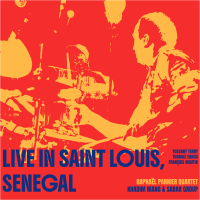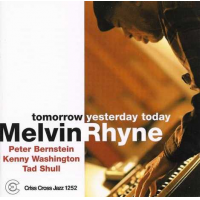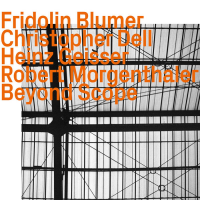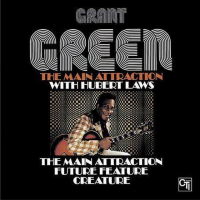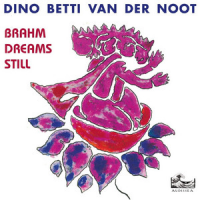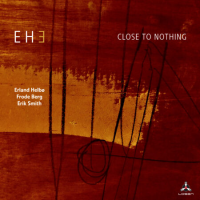Home » Jazz Articles » Liner Notes » Sergio Armaroli & Evan Parker: Dialog
Sergio Armaroli & Evan Parker: Dialog
Surviving medieval manuscripts show call and response to be a defining feature of contemporary European liturgical music, albeit precomposed rather than, as here, entirely improvised. And in those cultures which possess oral rather than written musical archives, we can reasonably assume an even older provenance. In Africa, the cradle of humanity, call and response extends into prehistory and remains central to music making across the continent today. In the African diaspora, it figures large in gospel, blues, various forms of jazz, son, salsa, rumba and so forth.
Karlheinz Stockhausen affirmed antiphony's place in modern European symphonic music when he made it a feature of Gruppen, which he composed for three coactive orchestras. Stockhausen completed the monumental work in 1957. The same year roots-modernist Charles Mingus wrote his miniature masterpiece "Original Faubus Fables," in which, with call and response centre-stage, he eviscerated Arkansas governor Orval Faubus for his refusal to comply with the US Supreme Court's ruling to desegregate the state's schools. In perhaps its most powerful recorded version, on the album Charles Mingus Presents Charles Mingus (Candid, 1960), the instrumental call and response between Mingus' bass and Eric Dolphy and Ted Curson's (vocalized) horns is augmented by vocal exchanges between Mingus and drummer Dannie Richmond.
So call and response has thoroughbred global bloodlines. But it was not Armaroli and Parker's first choice of format. Their original plan was to go into a recording studio together during a tour of Italy that Parker was scheduled to make in 2022, and lay down a set of freely improvised music in real time. As the start date of the tour approached, however, the plan fell apart because Parker became unable to leave Britain. For reasons which do not concern us here, he would have been unable to produce the obligatory medical certificate certifying him to be free of the Covid-19 virus, so allowing him to travel through mainland Europe. With regret, Parker cancelled the tour and the recording session with it. But, happily for us, Armaroli was keen to consider alternative scenarios.
The two players considered several options. At the time of writing, software is close to being signed off which will overcome the problem of temporal latency and allow musicians in distant locations to record together in real time without even micro-temporal lapses occurring between them. But the computer coding was still being finessed in October 2022. Nor was Parker prepared to overdub his improvisation over Armaroli's solos. "The idea of clamping a pair of headphones on and pretending to be in the same room does not appeal to me," says Parker. "Structurally, whatever I did would be on top of what was already there rather than in an interactive relationship with it."
The format Armaroli and Parker ultimately arrived at was (vibraphone) call and (saxophone) response using file sharing. "I have never before used file sharing in such an organic way," says Armaroli. "It has not been necessary. But the idea always precedes the possibility of concretely realizing a project. I mean, despite all negative circumstances it is possible to find a contact, a relationship, mediated first by the microphone and then by the distance which in listening is cancelled by presence. The result is a kind of a trans-improvisation that only the listener can create."
"We were on two different planes of reality," says Parker. "Different times, different places, brought together only as a final artefact. One person leads and another person follows, but it is still a conversation. It is like a Platonic exchange, in which Plato expounded a proposition and his pupils replied before he went on to the next proposition."
Dialog differs, however, from the classical Greek idea of dialectics, that of thesis-antithesis-synthesis, in one respect. There is thesis, from Armaroli, and antithesis, from Parker, but it is a third party, the listener, who provides the synthesis. And there will be as many syntheses, and as much diversity among them, as there are those of us tuning in.
Liner Notes copyright © 2026 Chris May.
Dialog can be purchased here.
Contact Chris May at All About Jazz.
Chris May is a senior editor of All About Jazz. He was previously the editor of the pioneering magazine Black Music & Jazz Review, and more recently editor of the style / culture / history magazine Jocks & Nerds.
Track Listing
Two Rooms One Vibraphone #1; Interlude 1; Two Rooms One Vibraphone #2; Interlude 2; Two Rooms One Vibraphone #3; Interlude 3; Two Rooms One Vibraphone #4; Interlude 4; Two Rooms One Vibraphone #5; Interlude 5; Two Rooms One Vibraphone #6.
Personnel
Sergio Armaroli
vibraphoneEvan Parker
saxophone, sopranoAdditional Instrumentation
Sergio Armaroli: vibraphone (1, 3, 5, 7, 9, 11); Evan Parker: soprano saxophone (2, 4, 6, 8, 10).
Album information
Title: Dialog | Year Released: 2023 | Record Label: Ezz-thetics
Tags
PREVIOUS / NEXT
Support All About Jazz
 All About Jazz has been a pillar of jazz since 1995, championing it as an art form and, more importantly, supporting the musicians who make it. Our enduring commitment has made "AAJ" one of the most culturally important websites of its kind, read by hundreds of thousands of fans, musicians and industry figures every month.
All About Jazz has been a pillar of jazz since 1995, championing it as an art form and, more importantly, supporting the musicians who make it. Our enduring commitment has made "AAJ" one of the most culturally important websites of its kind, read by hundreds of thousands of fans, musicians and industry figures every month.










